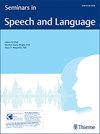评估成人失语症和非脑损伤成人语言自我评定的准确性:一项初步研究。
IF 1
4区 医学
Q3 AUDIOLOGY & SPEECH-LANGUAGE PATHOLOGY
引用次数: 0
摘要
失语症(PWA)患者的研究和临床实践中经常使用评定量表来表征家庭环境中的交流。然而,目前尚不清楚评分表上提供的回复是否准确反映了所发生的沟通。我们的目的是评估通过评定量表测量的PWA对语言使用的自我感知的准确性,并确定这种准确性是否与非脑损伤(NBI)参与者的准确性不同。四名PWA和四名NBI参与者完成了一份评估量表,评估了他们与交流伙伴相比的言语语言产生量。对参与者家庭环境中的录音进行分析,以确定参与者贡献的单词和会话转折的比例,并将其与评分量表估计值进行比较。PWA和NBI参与者对口头语言输出的感知显示出不同的准确性,两组的估计值和客观数据之间存在差异。评定量表在量化语言输出方面的可靠性似乎值得怀疑,这表明它们可能不能准确地代表PWA的自然语言环境。有必要对更大的样本量进行额外的研究,以调查这一趋势在更大的失语症患者群体中是否一致。本文章由计算机程序翻译,如有差异,请以英文原文为准。
Evaluating the Accuracy of Self-Ratings of Language in Adults with Aphasia and Non-Brain Injured Adults: A Pilot Study.
Rating scales are frequently used in research and clinical practice with people with aphasia (PWA) to characterize communication in the home environment. However, it remains unclear whether responses provided on rating scales accurately reflect the communication that occurs. We aim to evaluate the accuracy of PWA's self-perceptions of verbal language use as measured by a rating scale and determine whether this accuracy is different from that of non-brain-injured (NBI) participants. Four PWA and four NBI participants completed a rating scale estimating their amount of verbal language production as compared with their communication partner. Audio recordings from participants' home environments were analyzed for proportion of words and conversational turns contributed by the participant, which were compared with rating scale estimates. Perceptions of verbal language output among both PWA and NBI participants showed variable accuracy, with discrepancies between estimates and objective data across both groups. The reliability of rating scales in quantifying language output appears questionable, suggesting they may not accurately represent naturalistic language environments of PWA. Additional research with larger sample sizes is warranted to investigate whether this trend is consistent across a larger population of individuals with aphasia.
求助全文
通过发布文献求助,成功后即可免费获取论文全文。
去求助
来源期刊

Seminars in Speech and Language
AUDIOLOGY & SPEECH-LANGUAGE PATHOLOGY-REHABILITATION
CiteScore
2.40
自引率
0.00%
发文量
37
期刊介绍:
Seminars in Speech and Language is a topic driven review journal that covers the entire spectrum of speech language pathology. In each issue, a leading specialist covers diagnostic procedures, screening and assessment techniques, treatment protocols, as well as short and long-term management practices in areas such as apraxia, communication, stuttering, autism, dysphagia, attention, phonological intervention, memory as well as other disorders.
 求助内容:
求助内容: 应助结果提醒方式:
应助结果提醒方式:


